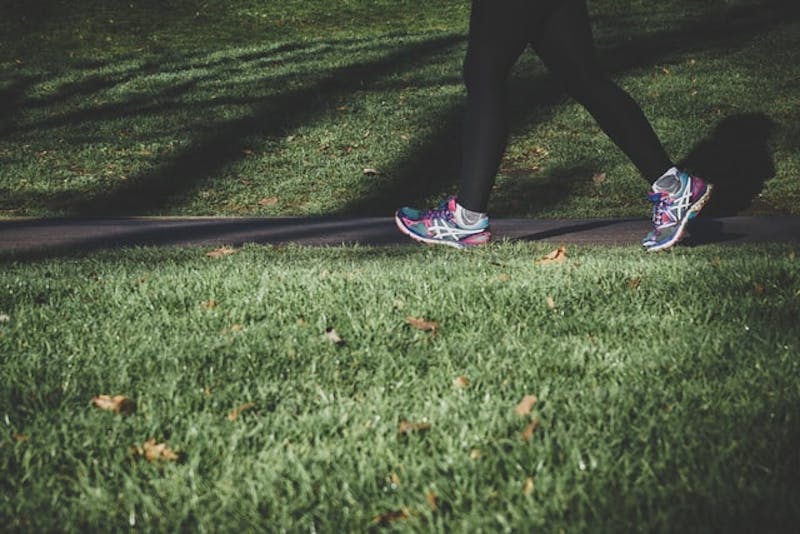
You don’t need to do extremely strenuous exercise to lose weight. Walking helps you lose weight faster than you’d expect and it will improve your overall health.
One of the biggest contributors to the health and obesity epidemic is that most of us find it hard to make time for exercise.
We’re busy—hectic work schedules, family obligations, frequent appointments and errands keep us from having much time to ourselves. There’s a lot we have to do each day that leaves little extra time to think about our own health.
So while we know how important exercise is, fitting it into our schedule is a whole separate struggle. There’s pressure to always burn a certain number of calories and attend workouts that take an hour or more. But the reality is that many of us don’t have time for all of that.
That’s why it’s important to think about the small but impactful ways to add more movement during the day.
And one of those is walking. It’s the simplest form of movement we can add to our day, and as it turns out, is also incredibly effective.
Walking helps you lose weight faster and manage your weight long term
More and more people are making big health and lifestyle changes by adding one thing to their routine: walking.
The stories have even been covered on major news outlets, like this story about one woman who lost 50 pounds by adding walking to her new healthy diet. And another story about a woman who lost 228 pounds by walking.
The results of walking are measurable and life-changing, but how does walking help you lose weight?
Walking helps you preserve muscle mass
The more muscle you have, the more efficiently you burn calories.
Muscles require more energy to maintain, so your body will use more of your stored energy to maintain your muscle mass. This is why having muscle also helps you burn more calories when at rest.
Walking helps you maintain more muscle in your lower body. You’ll never get “bulky” from walking, but you will have more muscle in your legs than if you are sedentary. And that additional muscle will help you burn more calories while at rest.
If you combine walking with strength training, even light strength training with just your body weight, you would see even more changes in how your metabolism processes energy.
Walking helps you burn more calories
As we spend so much of our time sitting each day, we burn fewer calories than we would if we were more active.
This is part of the problem with a sedentary lifestyle—if you’re sedentary, you can’t burn as many calories.
When it comes to weight loss, it’s important to be in a state where you’re burning more calories than you consume. This is called being in a calorie deficit.
Walking helps you lose weight faster by making it easier to get into a calorie deficit.
When you’re in a calorie deficit, your body starts using stored energy for fuel and the result is that you lose weight. And it doesn’t have to be a huge deficit to have an impact. Even a deficit of 100 to 200 calories will help you lose weight over time.
That’s why your diet is still the most important factor in losing weight.
But just because diet has the biggest impact on your weight, there are countless other benefits to walking for at least 30 minutes a day.
5 additional health benefits of walking
Yes, walking helps you lose weight, but that’s just one way it provides a positive impact on your body and life.
1. Improves heart health
More frequent exercise strengthens your heart and improves your cardiovascular heart. And it doesn’t have to be strenuous cardio to see results.
One group of researchers found that 30 minutes of walking at least five days per week reduces the risk of heart disease by 19%.
2. Boosts mood and energy levels
Walking improves oxygen flow throughout your body. This helps wake you up and keep you alert both immediately after your walk, and throughout the day. Plus, walking increases hormones like cortisol, epinephrine, and norepinephrine that boost your energy levels.
As for your mood, exercise increases the production of chemicals and hormones that elevate and moderate your mood. Multiple studies have shown that exercise–including walking–reduces anxiety, stress, and depression.
3. Reduces joint pain
While it may seem counterintuitive, staying active reduces joint pain.
The more you move your joints and keep them active, the more lubricated and stronger they become. Which in turn leads to less pain and stiffness over time.
4. Improves immune function
When it comes to the cold and flu season, it turns out that one of the best things you can do to prevent illness is to stay active.
One study that explored the impact walking has on immune function found that those who walk 30+ minutes per day were 43% more likely not to get sick or have to take sick days. For those who still got sick, their symptoms were less severe than when compared to sedentary adults who got sick.
5. Enhances creative thinking
Walking gives you a nice break away from your screen or from your work. It gives you a change of scenery and helps you stay alert throughout the day.
The result? More creative thinking.
It turns out that walking can help you think more creatively about problems and situations than just sitting idly. A study measured whether people were able to think of ideas more efficiently and effectively while sitting or while walking. The results showed that the participants who walked while brainstorming came up with ideas faster to solve a given problem—especially when they walked outside.
So if productivity motivates you, then walking actually helps you perform better in your work and creative projects.
How to start walking more
There’s no one right way to spend more time walking each day. It will depend on your schedule, your endurance, and your goals.
It’s also hard to start a new routine, even when it’s just walking more. So here are some ways to start adding more movement to your day that worked for our patients and others:
- Start slow. Walk 10 minutes per day for the first few weeks and then gradually add 5 more minutes until you reach 30 minutes
- Break up your walks into smaller chunks throughout the day. If it’s hard to get 30+ minutes to walk, you can
- Every little bit counts. Take the stairs when you can, choose to walk to nearby places instead of drive, take a short walk on your break at work. It doesn’t have to be perfect, just getting some movement goes a long way.
And if you’re ready for support and to see measurable and long-lasting results in your weight loss journey, we’re here to help.
In addition to helping you find time for walking and other types of exercise if it fits your goals, we also create a diet plan that fits your health and weight loss needs.
We know how hard it is to start a new routine and stick to lifestyle changes. This is why getting support is so important when you’re ready to make long-term changes. We’ve helped hundreds of patients throughout the Phoenix area successfully lose weight and keep the weight off.
To get a personalized weight loss strategy and the empowering and compassionate support to succeed, visit your closest Valley Medical Weight Loss Center. No appointment necessary—we’re ready to work with you.

